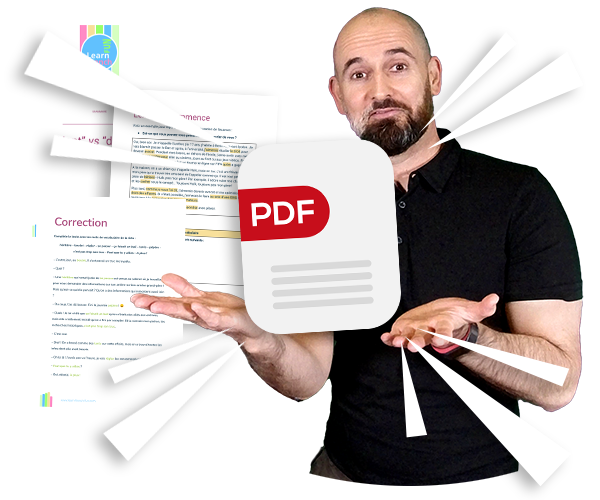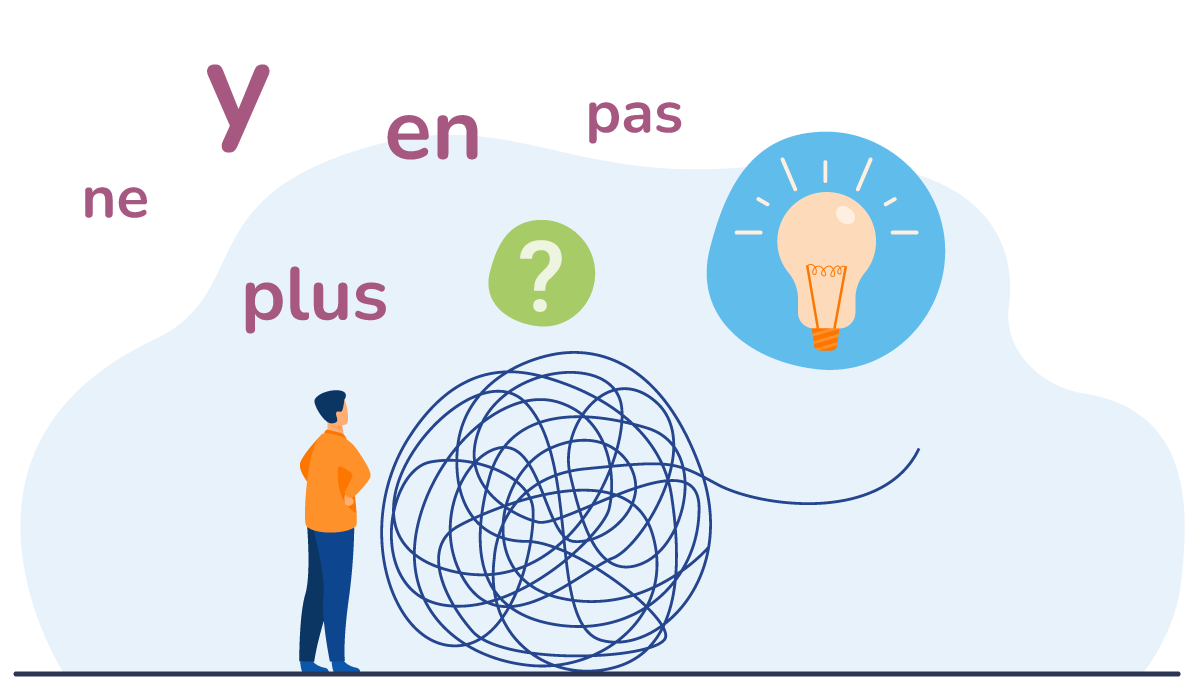Have you ever wondered where to place the negation words and pronouns in a French sentence? Wonder no more! In this blog post, I will explain the position of these words in a French sentence.
- How do you know where to put pronouns in French?
- Where do you put the negation in French?
- How do you negate a pronoun in French?
- French Compound Tenses (passé composé, plus-que-parfait…)
- Position of the pronoun and negation in French with modal verbs and the near future
- Position of the pronoun and negation in French with reflexive (pronominal) verbs
- ✔️ French QUIZ
- Articles that might interest you:

PDF Bonus
We have prepared a free PDF to help you understand and master the position of pronouns and negation words in French.
👉 Download it for free
At the end, you will have exercises to practice with the correction. 👍
- Tu fais du ski ?
- Je n’en ai pas fait depuis longtemps. Mais je veux en faire à nouveau.
What I noticed with my students was that understanding when to use y or en was pretty simple. Once they understand and learn the rules 😉, it’s no longer a problem to get it right.
In fact, the main problem is getting all the little words in the sentence right.
To solve this problem of word position, we will review together :
- where we put the pronouns
- and where we put the negation words
…and that, in the simple tenses… in the compound tenses… with modal verbs (vouloir, pouvoir, etc)… with the near future and with reflexive verbs.
How do you know where to put pronouns in French?
Let’s first look at the position of pronouns in the French sentence. What I’m going to tell you now works for all pronouns and all tenses.
Yes… Actually… in all tenses, not exactly! It doesn’t work like that in the imperative!
You know the imperative? When you give an order or an advice to someone: Sors ! (Go out!) – Mange ! (Eat!) – Prends ton parapluie (Take your umbrella).
But let’s leave the imperative aside for today, you can find our specific article about imperative.
Let’s go back to the position of the pronouns. It’s very simple, it’s right before the verb!
Easy?
But when I say : “just before”, I mean : JUST BEFORE ! Not: “just before, but I still put a little word between the pronoun and the verb”…
No no, just before!
Examples:
- Je veux du pain.
I know that here I have to use the pronoun en
My verb is: veux (vouloir)
so I put the pronoun right before the verb and it says:
- j’en veux !
- Tu voulais du pain ?
- J’en voulais.
- Tu vas au cinéma ?
- J’y vais.
Do you like learning French with videos?
Receive our free video newsletter every Friday in your e-mail box. You will get 3 “Tips & Tricks” on grammar, vocabulary, phonetics or French culture.
👉👉 Sign up now!
Where do you put the negation in French?
Okay, but we don’t always speak in the affirmative form. Sometimes we say: no
The position of the negation in French is also something very simple, it – encapsulates – the verb!
Encapsulates???
Yes, on both sides! You know that the negation is: ne… pas… / ne… plus… / ne… jamais… / etc
Well, the ne is put before the verb and the pas/plus/jamais… is put after!
How do you negate a pronoun in French?
Ok… But you will tell me that… “before”, there is already the pronoun! So… what?
Remember what I told you: the pronoun is before, before, BEFORE!
Before with the #1 priority of being before the verb!
So, the ne of the negation, it is a little less before… 😅
If you want, you can put a priority order:
- The pronoun has priority #1 to be before the verb
- and the negation has priority #2.
That means that if in a sentence you have the pronoun and the negation → The pronoun is just before the verb and the “ne” of the negation, just before the pronoun.
Examples:
- Je veux du pain → J’en veux.
- Negative form: je n’en veux pas.
- J’y vais
- Je n’y vais pas
French Compound Tenses (passé composé, plus-que-parfait…)
So far, I think everything is going well for you! Where it gets a little more complicated is with the French compound tenses.
Just a reminder, in the compound tenses, you find: the passé composé, plus-que-parfait, conditionnel passé, subjonctif passé, etc.
First the position of the pronoun: It doesn’t change! Priority n°1, before the verb.
- J’ai voulu du pain.
- J’en ai voulu.
This gives us the structure:
Subject + pronoun + to be/have + past participle
Negation in French compound tenses
Then there is the problem of negation. One thing that is nice here is that the position of the negation words for the compound tenses NEVER changes!
It’s always this structure:
Sujet + ne + être/avoir + pas/plus/jamais… + participe passé
Example:
- Je n’ai pas voulu de pain
So, finally, it’s not very complicated to add the pronoun? Indeed, it has a number 1 priority, it is BEFORE the verb.
💡 Remember that ai (avoir) is part of the verb… So we will put the pronoun just before the auxiliary.
The structure for negation in French compound tenses is:
Sujet + ne + pronom + être/avoir + pas/plus/jamais… + participe passé
Je n’en_ai pas voulu. (Don’t forget to make the connection → je n’en_ai…)
| 👉 Do you want to be able to remember all these rules easily? We’ve prepared a free Bonus PDF with the summary of the lesson on the position of pronouns and negation words in the French sentence. With exercises and corrections to practice. So, download it right now 👍😀 |
Let’s break down an example together:
QUESTION:
- Tu es allé au ski ? (Did you go skiing?)
ANSWER:
- Subject? Je
- Negation (part 1) ? ne
- Pronoun ? “Au ski” → pronoun y
- Verb (part 1, because it’s a compound tense = auxiliary): With the verb aller, I know I have to use être, so: suis
- Negation (part 2, the most important part of the negation!) : pas
- Verb (part 2 = past participle): allé
→ Je n’y suis pas_allé. (again, don’t forget the connection)
Position of the pronoun and negation in French with modal verbs and the near future
Now let’s look at the case with the modal verbs (vouloir, pouvoir, devoir), also the verb aimer + infinitive, and the near future tense. All these verbs work in the same way.
| 📌 Quick reminder, the near future? Je vais partir. It’s the verb aller in the present tense + infinitive. You’ll find our specific video on YouTube that explains all this if you forgot. |
So, does the rule change? No !
In fact, it remains the same logic. The only thing you need to pay attention to is the “real” verb in the sentence, the verb that gives meaning to your sentence.
When you say: Je dois partir. What is the “real” verb?
- dois ?
- partir ?
It’s partir of course. Dois is the modal, which expresses the “how”. Here, for you, it’s an obligation → you have to.
And the same goes for the near future
Je vais partir. Vais is only used in the formation of the near future. It’s partir that gives the information.
I know, you could tell me that in the compound past tense, it should be the same logic. Être or avoir are only used to make the passé composé…
Yes… but, no!
Listen, it’s French after all! You have to complicate things a little bit 😂
Now that you know which is the real verb, when there is a modal or in the near future, you apply the rules you already know about the position of the pronoun and/or the negation:
- Tu dois prendre du pain.
- → Tu dois en prendre.
Right before the real verb.
- Tu as dû prendre du pain ?
- → Oui, j’ai dû en prendre.
⚠️ BEWARE, remember that the real verb is prendre.
- Non, je n’ai pas dû en prendre.
You see,
- we conjugate our modal (present tense, past tense, whatever),
- put it in the affirmative or negative form depending on what we want to say,
- and then, since we have the real verb, right BEFORE, we put the pronoun.
And it’s the same thing with the near future:
- Tu vas aller au ski ?
- Oui, je vais y aller.
- Non, je ne vais pas_y aller. (I make the connection)
Position of the pronoun and negation in French with reflexive (pronominal) verbs
If you are still reading this article, it means that you are a warrior of the French language.
The last hurdle you’ll ever encounter. It’s with reflexive (pronominal) verbs: se… (se lever, se coiffer, se rendre…)
Again, nothing changes! It’s just a new priority rule that appears.
Until now, we had:
- Priority #1 before the verb: the pronoun
- Priority n°2 before the verb: the negation (ne)
Now, we will have :
- Priority n°1 before the verb: the pronoun (it doesn’t change)
- Priority n°2 before the verb: the reflexive pronoun (me, te, se…)
- Priority #3 before the verb: the negation (ne)
Clearly, the ne of the negation, it has a very small priority.
So small, that very often the French don’t even say it!
Let’s take an example: se mettre du parfum (putting on perfume).
- Est-ce que tu te mets du parfum ?
- Oui, je m’en mets.
- Non, je ne m’en mets pas.
- Est-ce que tu t’es mis du parfum ? (passé composé)
- Oui, je m’en suis mis.
- Non, je ne m’en suis pas mis.
As you can see, the rule hasn’t changed. You just have to pay attention to the order of priority of the words before the verb.
✔️ French QUIZ
Position des pronoms dans la phrase
Before leaving, let’s take this little quiz together to see if you understand 😀
Results
#1. Choisis la réponse correcte à la question "Est-ce que tu aimes écouter des chansons françaises ?"
#2. Choisis la réponse correcte à la question "Est-ce que tu as eu besoin de ma voiture ?"
#3. Choisis la réponse correcte à la question "Est-ce que tu vas partir en Australie ?"
#4. Choisis la réponse correcte à la question "Est-ce que tu veux une bière ?"
#5. Choisis la réponse correcte à la question "Est-ce que tu es déjà venu en France ?"
📌 Free PDF Bonus:
Do you want to do more exercises on Position of French pronouns in the sentence and have the correction? Have a summary sheet of the lesson?
Then download the free Bonus PDF!
I hope it’s a bit clearer for you 😀
And rest assured, before you can use pronouns in the right place in everyday discussions… with reflexive verbs in compound tenses… you’ll get it wrong a thousand times first!
But that’s okay! Step by step, you’ll make fewer and fewer mistakes!
And don’t forget to download the Little Bonus PDF, which contains a summary of what we’ve just seen and many exercise sentences to practice.
And above all, speak French as much as possible! Bye, see you soon 🌞
Articles that might interest you:
- The Imperative in French: How to Conjugate Verbs in Imperative? When do You Have to Use the Imperative?
- The 10 Irregular Verbs in the French Subjunctive Mood
- Depuis, pendant, en, il y a, dans
- All the secrets of the French gerund!
- French verb moods
- How to use the tonic pronouns in French?
- How to use “en” and “y” pronoun in French?
- Difference between DONT and DUQUEL in French
- 10 common French verbs conjugated in the present tense. Beware of traps!
- The Direct Object Complement in French (C.O.D.) and direct complement pronouns (le, la, les…)







2 thoughts on “Position of pronouns and negation words in French”
Comments are closed.